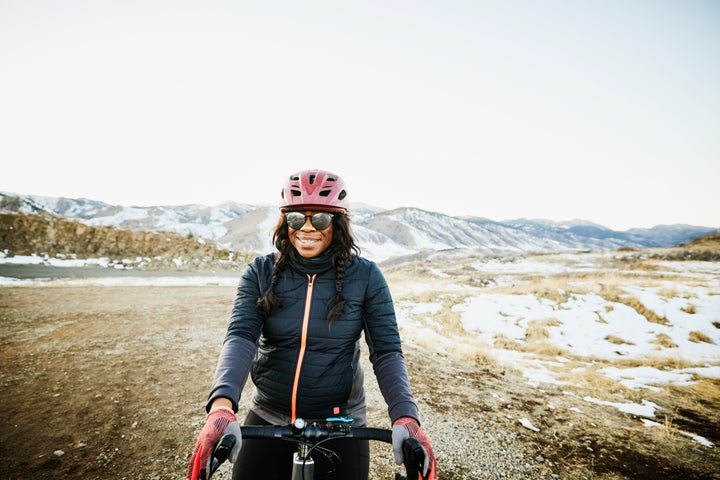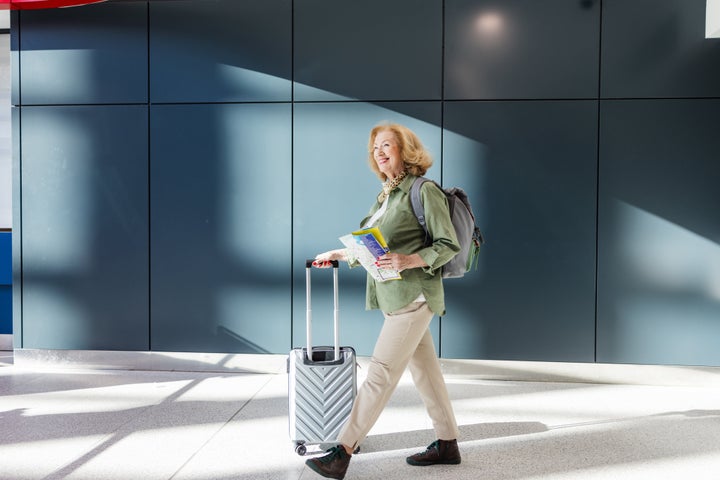From hiking in Peru to sea-kayaking in Australia, participating in out-of-the-ordinary experiences is becoming a must-do for many people ― particularly for female travelers. In fact, adventure travel ― defined as a travel experience “that involves the combination of nature, culture and physical activity” ― is on the rise.
Women make up over half of the bookings with adventure travel companies, according to data from the Adventure Travel Trade Association. A global study of 1,000 women found that adventure travel was the most sought-after type of travel among those over age 50. And Kelly Kimple, chief executive officer of Adventures in Good Company, an adventure travel company for women, said that she’s seeing more clients over the age of 40.
“We’re seeing more women aged 40 and older gravitate toward adventure travel for a few key reasons,” Kimple said. These travelers are often taking more adventurous vacations as a way of navigating life transitions. They may be at a soul-searching stage and desire something to jar them out of the mundane. Or maybe they’ve always wanted to try it, and it is only now that they have the financial resources and time to do so.
“Additionally, the adventure travel space itself has become more welcoming and inclusive, providing women with more opportunities to embrace this type of travel,” Kimple explained. For the most part, these opportunities allow women to immerse themselves in the destination’s culture while also participating in activities like traipsing through caves, crossing a tortuous mountain pass, dog-sledding in the snow or quietly observing African gorillas.
You might even travel on a long wooden boat for three hours, deep into the Amazon rainforest. That’s what my aunt did at age 63. With seven of her colleagues, all women, they took a guided tour into the jungle. They caught and ate a piranha, trekked to see vibrant Amazonian birds and towering Brazil nut trees, battled swarms of relentless mosquitoes and a large hitchhiking roach, stayed in a lodge that only had an hour of electricity a day, and carefully avoided stepping on snakes each time they left their room for dinner. It was a once-in-a-lifetime experience, she told me.
My aunt wasn’t always this dauntless. But over the several adventure trips she’s done, she has always been rewarded with the bliss of experiencing something she’d never imagined before. Now, her appetite for adventure is whetted.
Itching to try something similar? Here’s your expert-backed guide on preparing for an adventure trip, if you’ve never done it before:
Narrow down where you want to go and make an itinerary.
To get some inspiration, click through trip offerings on adventure travel websites. You’ll start to notice that a trip doesn’t have to be as physically challenging as you might expect, it may simply include an outdoor activity that is out of your usual routine.
Adventures in Good Company has their itineraries rated between levels 1 to 5, with level 1 being the most relaxed and level 5 being the most physically challenging. On level 1 trips, you’ll get to do lighter activities, like a couple miles of kayaking or a short bike ride, Kimple said. But if you’re opting for a level 5 trip, “We emphasize that people give themselves time to train and prepare because it’s back to back days of physically challenging experiences with not as much rest time in between.”
Ask yourself where you’re at in terms of physical capacity, then match it up to one of the offerings. This can help you make decisions for your own itinerary planning as well.
Karen Warren, an outdoor adventure program risk assessment expert who has decades of solo adventure travel experience, is a lover of itineraries. Her top tip for adventure itinerary structure? Start the trip with easier or lower mileage activities, build to more challenging activities in the middle, then taper it down toward the end. Avoid packing out the itinerary during the first and last couple of days.
Her main reason for bookending the itinerary with relaxed days is that people are most distracted at the beginning (“they’re still checking everybody out, trying to figure out their own confidence, where they fit in.”) and at the tail end of a trip (“they’re distracted by the thought that they’re leaving soon, or maybe they had a terrible time so are distracted by this guilt that they paid all this money for the trip.”) Being distracted can increase the risk of accidents, said Warren.

Recognize that traveling solo, with friends, or a group of strangers requires different preparations.
If you do feel ready for a solo trip, select accommodations with active hosts, as they’ll be able help you with things like booking a driver or doctor’s appointment, Warren said.
Plan to arrive a few days earlier than your itinerary officially starts, said Kimple, and hire a day guide to familiarize you with the terrain and climate conditions, examine your pack and equipment, and conduct a safety briefing before you start your activity. Another option is a self-guided tour, said Deb Ajango, a wilderness medicine and risk management educator and owner of SafetyEd.
If you’re traveling with friends, set up a time (or several) to hold honest pre-trip discussions. “Go into it with genuine curiosity, that we’re trying to make this a successful trip for everyone, are our skills and expectations going to match?” Warren said. “The skills don’t have to match exactly. I’ve taken lots of beginners on trips where they were willing to learn and try things out, and that made them perfect for the trip.”
Below are some sample questions to get you started, according to the experts:
- How do you feel about the potential climate conditions we may encounter?
- How hard do you want to go, physical strenuousness and mileage-wise?
- What are everyone’s expectations about rest days and relaxation times?
- How do you feel about everyone splitting off and having some introverted me-time toward the end of each day?
- How comfortable is everyone with X, Y, Z aspects of the activity? (If paragliding or zip lining, how comfortable is everyone with heights, for example)
- What are everyone’s physical capacities like, and does it match up with what’s required on the trip?
- What are everyone’s expectations with managing risk? What are everyone’s ‘no-compromises’? Can we agree on a risk checklist and action plan?
If you prefer to go with a group of like-minded women you may not know, there are a number of companies in the U.S. that design women-led adventure trips.
Before signing up, Warren recommends asking the organizer about their safety policy, the level of experience that’s expected of the trip participants, how physical it’s going to be, and what kind of physical capacity you need to join the trip.
Research, research, research, then compile a list of potential risks.
The experts recommended researching any foreseeable risks, such as the climate, weather changes and warnings, terrain and altitude, tidal conditions, political unrest, harmful flora and fauna, and communicable diseases, putting together a list of potential hazards.
“You’re not trying to get paranoid. You’re trying to become a savvy detective in recognizing the things around you so you’re not surprised by them,” explained Ajango, who uses a risk checklist to inform her research. For example, you might include a list of medical facilities that can speak your language or treat foreign passport holders, important phone numbers, or locations of emergency shelters.
The majority of this information can be accessed online, but some of it may need to be gathered on location. So don’t be shy; push yourself to speak to trustworthy locals or expats. They can give you the crucial information you cannot find on the web.

Familiarize yourself with local customs.
The last thing you want to do is be inadvertently disrespectful or harmful to the people living at the destination. Do some research beforehand of the customs, traditions and social norms, and speak to locals or foreigners who have lived in your destination. Above all, approach the cultural differences with an open mind and positivity.
Leading up to the trip, build your confidence and physical capacity.
To increase confidence, it may be beneficial to do the activity, take day trips, and glean insight from seasoned travelers, Warren said. To help travelers build fitness before a trip, Kimple’s organization provides a preparation guide, which includes advice like carrying a filled pack while venturing out into different conditions and terrains, and testing and breaking in your gear and equipment.
Ajango advised getting into the habit of paying attention to your surroundings. It’s to assess hazards, yes, but also to enable you to trace your steps back to a safe location should you lose phone reception. This is true even if you choose to go on a guided trip.
“It’s the people who think, ‘Oh I paid [the guide] to make the decision, so I don’t have to pay attention,’ those are the folks that generally are going to be really stressed out and make poor decisions,” she said.
Ensure your travel documents and reservations are in order.
As a general rule, check that your passport is valid for more than six months after your final day in your destination. If you need to apply for one, factor in the time it would take to be delivered to you.
Support Free Journalism
Already contributed? Log in to hide these messages.
You might want to consider purchasing travel insurance as well, Kimple advised. If you’re going to more rural or remote areas, get travel insurance that will cover you in those locations.
Finally, make activity reservations ahead of time, especially if they are in tourist hot spots. Nowadays, you’ll likely need to book to visit places like national parks, so plan ahead.
Support Free Journalism
Already contributed? Log in to hide these messages.
